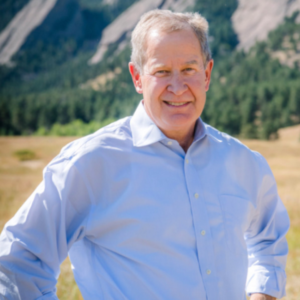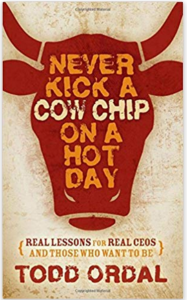“I think my counsel to CEOs is you have to lead. If you don’t lead, someone else will,” said Todd Ordal.
The CEO role and the internal capabilities required to grow a company are rapidly being redefined. The New CEO is grappling with a:
- Shift from shareholder to stakeholder
- Seismic demographic, ethnic, and gender transference from Baby Boomers to Gen Xers, Millennials, and Gen Zers
- Reimagination of physical products to digital products and multiple services
- Recognition that understanding customer behaviors, not transactions are redefining customer relationships,
- Realization that we’re in a Gilded Age where the veneer of everything is great to the Authenticity Age where leaders, consumers, and communities are leveraging social business and corporate social responsibility to solve the challenges we face.
If I had one word to describe Todd Ordal, President of Applied Strategy, it would be Coach. A coach to CEOs for mid-cap companies with revenues in the $50 million to $2 billion range for almost 15 years, he is the former CEO of two medium-size companies: a sporting goods and design wholesale firm and a learning disabilities company. He was also the former Division President of Kinko’s. As Todd notes, he has the scars and the lessons he’s learned along the way that informs how he thinks about the CEO role.
In Part Two of the four-part series, we’ll discuss what Todd Ordal’s experience was like when he became a CEO, what the role of a leader is, how a CEO should manage their relationship with the board, and why it’s critical to know when to leave. Read Part I of the series here.
_____________________________
Carla A. Fleming (Fleming): How did you get your first CEO job? What was day one like?

Todd Ordal, President, Applied Strategy. Photo Credit: Todd Ordal.
Todd Ordal (Ordal): It was awful since I was the fix-it guy. The two founders of the sporting goods and design/wholesale company didn’t enjoy me much at all. They never had a boss. One of them was actually asked to leave after my first week.
The other guy stayed for quite a while. He was the brains of the operation, very creative guy. But, he was very manipulative. Hated my guts. So, we found a way to co-exist for a bit. I mean, that was just me boxing him around the ears. And, he had the staff turned against me. Half of our customers he had turned against me as well. So, I had to work on building credibility within the company. At the same time, we were running out of cash. We had violated bank covenants. We had problems in China. We had all sorts of stuff going on at this time.
Fleming: So, the first day was awful. How long before the second founder left?
Ordal: He was there after I left. We found a role for him, a creative role.

Sporting Goods. Photo Credit: Canva.
He was the product and the brains behind the product development. I was there for a couple of years. Then I got recruited away. They were a week away from bankruptcy when I go there.
We were able to pull them out of that and just generate some more revenue. We also got some help for the organization. But, I said to my board about a year and a half in, I know how to fix the broken stuff here. What I don’t understand is how we’re going to win in our marketplace in the long-term.
By the way, they had no answer when I said, “When you bought this thing, what did you think about the long-term viability of this little company within the larger marketplace? Why would they win versus somebody else?”
They didn’t have a great answer.
Fleming: Then, what happened?
Ordal: After fighting fires for a couple of months, I walked into my office one day and shut my door in my little office. And, I thought, what do I do now? I mean, I knew what to do for the last few months because there were all of these problems in front of us and the fires are kind of down to smoldering ash. What do I do?
Regardless of the size of a company, if you’re the CEO, the owner, or an entrepreneur, you have to be the one to answer that question. That was a good experience. It wasn’t fun all the time, but it was a good experience.
Fleming: Once you put the fires down, what was the reaction of the employees since the founder had turned people against you and now, you’re making the situation better. Did something change?
Ordal: I would say that a good majority of them probably came to see the changes as positive. I had a CFO that left at the same time as I did who was very talented. The employees saw us as competent and, I think they, in fact, a couple of them became kind of friendly.
I just had lunch with one of the guys from that company. He did product development and we maintained a bit of a relationship. He’s the only one. They got more positive over time. I’m a no-BS guy. I just don’t put up with a lot of baloney. It’s like you can get on my boat or we can put on this thing together, or you can get off it. I don’t care. Make a choice.
That’s kind of the way I approach it. We had a few people leave, I guess.
Fleming: You got recruited into the second company, which was a medical device organization?

Learning. Photo Credit: Canva.
Ordal: Well, not a medical device. We tested and treated learning disabilities. This was a UK based operation with a very entrepreneurial guy over there. It was sort of hands-on, interaction with adults and children, primarily more with children who are struggling with learning and attention disorders.
They had a regiment of testing and intervention that they were using in the UK which was having some real good anecdotal evidence. We never got around to doing anything really hardcore, gold-standard research. We started down the path, but that’s expensive to do.
This was an interesting one, very entrepreneurial. I got them to break-even within about two years.
I then really got sideways with a couple of board members and just told them I didn’t think I was the guy to help them move forward. They wanted me to do some things I thought I just couldn’t buy off on.
As CEO, I think if they say we don’t accept your strategy, or you say you’re trying to force a strategy on me that I can’t accept, you’ve got an obligation to leave. I didn’t like what they were proposing to do and left. In fact, they killed the company. I think it took them 18 months to take it to zero. And, I wrote a very large check into that company too, so I lost that.
Definitely, that was a tough one. That was a tough one. A very cool experience in many regards. I have a bunch of learning disabilities in my family. So, it helped me better understand those people and the whole awareness piece. I got to spend a lot of time with medical doctors and psychologists. It was a cool experience in that regard.
Fleming: At some companies, if you’re privately held, it may be the family that’s the board. Publicly traded companies have a board. Entrepreneurial companies privately held may or may not have a board. What’s it like to manage a board or work with a board?
Ordal: I worked for some boards. I’ve been on a bunch of boards. I’m on a public board right now. I’ve done some projects with boards in different capacities. Managing a board is an interesting thing.
If you have an Advisory Board, they’re basically taking your agenda as CEO or owner. I’ve been on Advisory Boards. If I want to talk cashflow, you’re going to talk about the new product. But, what they’re not there usually to do, unless you give them license to do it, is to hold you accountable.
Advisory Boards have no fiduciary responsibilities. Even if you say to them, I’d like you to help me be accountable, maybe they will or maybe you’ll let them do that. My experience is often times people won’t. They want advice, but they don’t want to be uncomfortably held accountable. Some of them probably do.

Advisory Board. Photo Credit: Canva.
If you’re on a Fiduciary Board, I mean a public board, it’s different. You’re supposed to stick your nose into things. But, the CEO has to lead the company. I think there has to be a fairly bright line between fiduciary responsibility and leadership. When a board starts trying to tell a CEO exactly how to lead a company, what their strategy should be, or acting as the senior leaders of the team, that’s when they’re way out of line.
I think CEOs have a leadership obligation to the Board to say, “Here’s what I need from you. I recognize I work for you and at the end of the day, you have to either accept or reject my strategy. You hold my compensation and employment in your hands. But, I want to make sure that you’re adding value to the company as well.”
I think my counsel to CEOs is you have to lead. If you don’t lead, they’ll lead.
If the Chairman of the Board has a strong personality and you do not lead, they’re going to tell you what to do. And then it’s no longer your plan. That’s the problem. Your question is a good one. It’s an interesting dance.
Fleming: When a CEO gets into a situation where the board’s leading, how do they recover or regain equal status? Or leadership status?
Ordal: That’s a great question. I think you have to have a heart-to-heart.
I think you’re going to have to start saying, “I’ve been remiss here. I haven’t given you what I should have been giving you. And, what I should be giving you is a clear path to success. Sharing results with you, telling you what I’m going to do. So, I’ve allowed my lack of leadership in those areas the board has stepped into and I need to change that a bit. Going forward, here’s what I suggest we do.“
I think it’s hard to recover from that once you get there.
Fleming: As a CEO Coach, how do you help CEOs see that situation, either if they’re in it or before they get there?
Ordal: You have the conversation. CEOs are usually acutely aware of it.
I’ve worked with CEOs who are at the beck and call of every individual board member. They’ll drop everything to jump at requests of the board. I think that’s a mistake. I mean, they’ve got a business to run. One of the things I encourage people to do when they take a new role, whether it’s CEO or senior marketing leader, whatever it might be, is to sit down and have an expectations meeting.
“I want to spend the afternoon with you all. I want you to tell me what you expect from me as a leader.” You write them all down and discuss them. You say, “I’ve got ten things on the board here, and I can comply, and I will do my damnedest to comply with six of them. But there are four I can’t. But let me tell you why. Not only that, let me tell you what my expectations are.”
Here’s how I’m getting evaluated by my boss or the board. “My expectations are A, B, and C.” So, everybody walks out of there saying, “Hey, we get where he’s coming from.” And, I as a leader say, “I understand what you’re looking for as well.” I think you have to do it with your board as well.
In Part 3 of our series with Todd Ordal discusses the importance of developing internal capabilities – at the company level and for the CEO – if both are to continue to grow.
 In “Never Kick a Cow Chip on a Hot Day: Real Lessons for Real CEOs and Those Who Want to Be,” Todd Ordal discusses what he learned when he sat in the CEO role and what executives who want to become CEOs need to learn about themselves, their teams, and their company to be successful.
In “Never Kick a Cow Chip on a Hot Day: Real Lessons for Real CEOs and Those Who Want to Be,” Todd Ordal discusses what he learned when he sat in the CEO role and what executives who want to become CEOs need to learn about themselves, their teams, and their company to be successful.
Photo Credit: Canva.
If you find this interesting, please share on LinkedIn, Twitter, Instagram, or Facebook.



You must be logged in to post a comment.